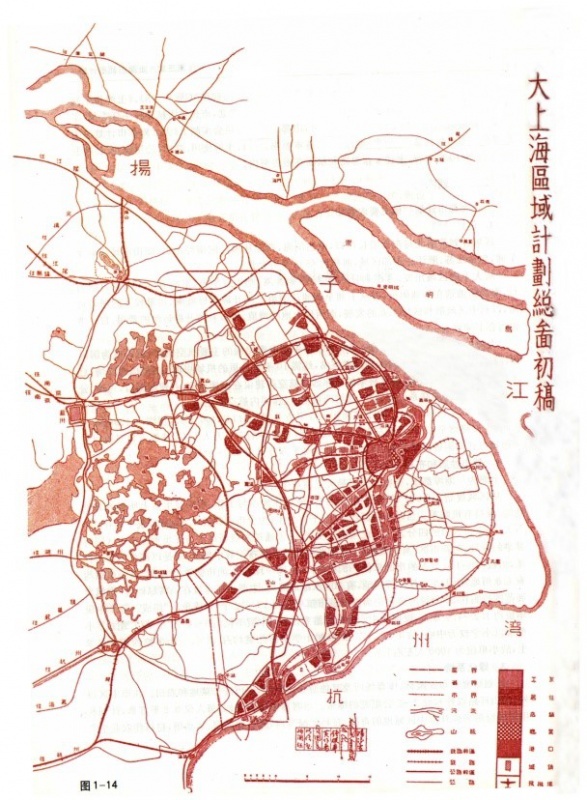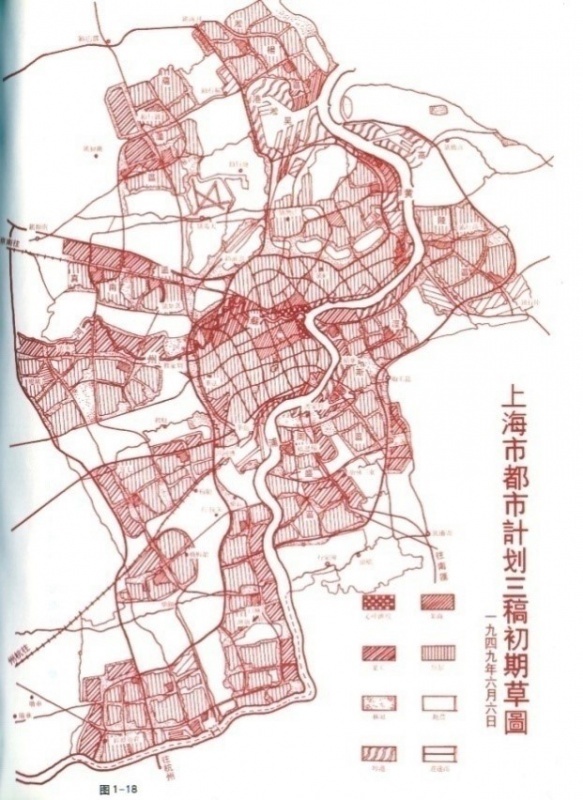Shanghai Master Plan 1946
Following the defeat of the Japanese and the end of the Second World War, work quickly began on new plans for the city. The Shanghai Master Plan began development by the Shanghai City Planning Board in 1946, the year of their establishment. This plan greatly emphasized long term regional planning, with objectives to be implemented in successive stages over the course of 25 years. The Master Plan's goals were influenced by an assessment of the shortcomings and successes of the Greater Shanghai Plan, as well as by pressing post-war economic concerns.
The Master Plan outlined more functional zoning rules for the city, as well as calling for the dispersal of Shanghai's exploding urban population to "satellite towns" in order to reduce crowding in the main city. The Master Plan also aimed to improve transportation in and around Shanghai, particularly focusing on the coordination of new rail junctions and the potential creation of a subway or above ground rail system in the city. Another pressing concern was the redevelopment of Shanghai's port, which had not been dredged during the Japanese occupation and whose level of disrepair was an imminent national crisis, as 43.79% of China's total imports and 57.72% of its exports passed through Shanghai.
Perhaps the highest priority of the Master Plan was the development of the Pudong area on the East bank of the Huangpu river. Pudong was an agricultural district that had historically remained underdeveloped compared to Puxi, the area on the West bank of the Huangpu where the rest of Shanghai was situated. Pudong's development had been limited by the lack of cross-river connections over the Huangpu, as well as by the fact that Pudong lay outside of the foreign concession's jurisdiction and therefore had not been one of their planning priorities. Now that control of Shanghai had been returned to the Nationalist Government, development of Pudong could begin. The Master Plan therefore directed that multiple bridges and a cross-river tunnel be built in order to allow traffic to and from Pudong.
Interestingly, the Shanghai Master Plan's focus on regional economic growth and coordinated development of transportation and industry was reminiscent of post-war urban plans in other parts of the world, such as the 1944 Greater London Plan or the plans of the National Resources Planning Board in the United States. This similarity may have been the result of the influence of foreign technical experts, many of whom collaborated on or were consulted for the plans. Another potential explanation for this similarity was that the Master Plan's goals all lent themselves to a stronger national defense, which was an imperative that many nations were experiencing after the violence of the Second World War.
The above maps show two drafts for the Shanghai Master Plan. The transition to broader regional planning is visible in the increased scale of the drafts, which both encompass a much larger area than previous plans. Even the sprawling vision of the Greater Shanghai Metropolitan Plan included on the previous page is visibly smaller in scope than these plans, depicting much less of the Pudong area.
Despite the Master Plan's grandiose scale and its laudable efforts towards modernizing life in Shanghai, it had major shortcomings. The municipal government of Shanghai was chronically low on funds, necessitating Shanghai's planners to repeatedly petition the central government for aid. By 1947, the municipal government's deficit had become so large that the central government refused to grant more funding until Shanghai balanced its budget. Furthermore, the Master Plan for Shanghai ignored many issues plaguing the city's citizens, such as the lack of basic utilities that persisted in the wake of occupation.
Implementation of the Master Plan eventually ceased after the fall of the Chinese Nationalist Government, but laid the foundation for the modern ethos of urban design in China. The development of the area of Pudong, the construction of bridges across the Huangpu River, and the construction of satellite cities around Shanghai are all projects that have since succeeded with the same core principles as outlined under the 1946 Shanghai Master Plan.

